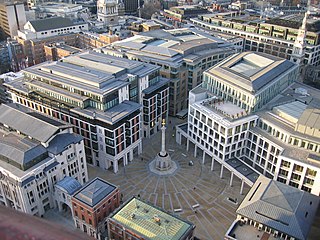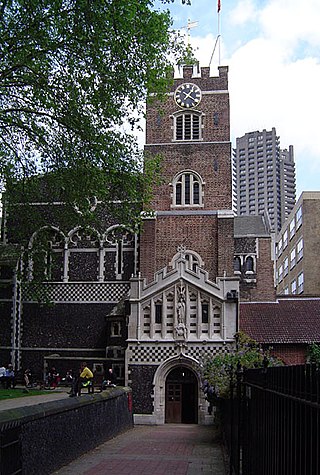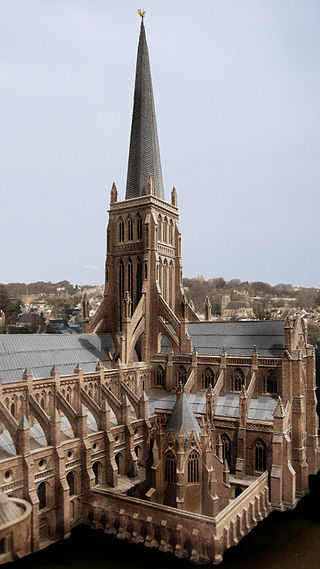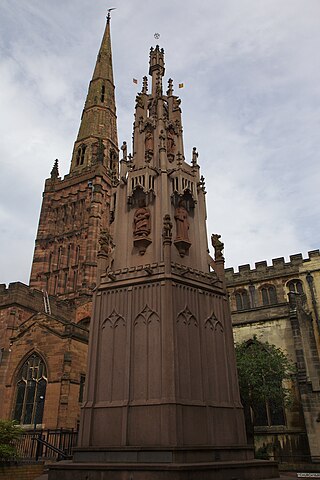
Alexander Pope was an English poet, translator, and satirist of the Enlightenment era who is considered one of the most prominent English poets of the early 18th century. An exponent of Augustan literature, Pope is best known for his satirical and discursive poetry including The Rape of the Lock, The Dunciad, and An Essay on Criticism, and for his translations of Homer.

St Paul's Cathedral is an Anglican cathedral in London, England, the seat of the Bishop of London. The cathedral serves as the mother church of the Diocese of London. It is on Ludgate Hill at the highest point of the City of London. Its dedication in honour of Paul the Apostle dates back to the original church on this site, founded in AD 604. The present structure, which was completed in 1710, is a Grade I listed building that was designed in the English Baroque style by Sir Christopher Wren. The cathedral's reconstruction was part of a major rebuilding programme initiated in the aftermath of the Great Fire of London. The earlier Gothic cathedral, largely destroyed in the Great Fire, was a central focus for medieval and early modern London, including Paul's walk and St Paul's Churchyard, being the site of St Paul's Cross.

Longman, also known as Pearson Longman, is a publishing company founded in London, England, in 1724 and is owned by Pearson PLC.

Paternoster Square is an urban development, owned by the Mitsubishi Estate, next to St Paul's Cathedral in the City of London. The area, which takes its name from Paternoster Row, once centre of the London publishing trade, was devastated by aerial bombardment in The Blitz during World War II. It is now the location of the London Stock Exchange which relocated there from Threadneedle Street in 2004. It is also the location of investment banks such as Goldman Sachs, Merrill and Nomura Securities, and of fund manager Fidelity Investments. The square itself, i.e. the plaza, is privately owned public space. In 2004, Christopher Wren's 1669 Temple Bar Gate was re-erected here as an entrance way to the plaza.

The Priory Church of St Bartholomew the Great, sometimes abbreviated to St-Barts-the-Great, is a mediaeval church in the Church of England's Diocese of London located in Smithfield within the City of London. The building was founded as an Augustinian priory in 1123. It adjoins St Bartholomew's Hospital of the same foundation.

The Second Great Fire of London in December 1940 was caused by one of the most destructive air raids of the Blitz during World War II. The Luftwaffe raid caused fires over an area greater than that of the Great Fire of London in 1666, leading one American correspondent to say in a cable to his office that "The second Great Fire of London has begun". Fires started by the raid included an incendiary bomb that broke through the dome of St Paul's Cathedral, which was being guarded by a fire watch team at the behest of the Prime Minister Winston Churchill.

Clan Elphinstone is a Lowland Scottish clan.

Paternoster Row is a street in the City of London that was a centre of the London publishing trade, with booksellers operating from the street. Paternoster Row was described as "almost synonymous" with the book trade. It was part of an area called St Paul's Churchyard.
The Ivy Lane Club was a literary and social club founded by Samuel Johnson in the 1740s. The club met in the King's Head, a beefsteak house in Ivy Lane, Paternoster Row, near St Paul's Cathedral, London.

Old St Paul's Cathedral was the cathedral of the City of London that, until the Great Fire of 1666, stood on the site of the present St Paul's Cathedral. Built from 1087 to 1314 and dedicated to Saint Paul, this building was perhaps the fourth such church at this site on Ludgate Hill, going back to the 7th century.
Events from the year 1711 in Great Britain.

St Benet Fink was a church and parish in the City of London located on what is now Threadneedle Street. Recorded since the 13th century, the church was destroyed in the Great Fire of London of 1666, then rebuilt to the designs of Sir Christopher Wren. The Wren church was demolished between 1841 and 1846.

St Faith under St Paul's in Castle Baynard Ward was an unusual parish within the City of London. It originally had its own building to the east of St Paul's Cathedral, serving as a parish church for the residents of St Paul's Churchyard and Paternoster Row, but this was removed in 1256 to allow for the eastern expansion of the Cathedral. The parishioners were instead given a space to worship within the cathedral crypt.

Paul's Cross was a preaching cross and open-air pulpit in St Paul's Churchyard, the grounds of Old St Paul's Cathedral, City of London. It was the most important public pulpit in Tudor and early Stuart England, and many of the most important statements on the political and religious changes brought by the Reformation were made public from here. The pulpit stood in 'the Cross yard', the open space on the north-east side of St Paul's Churchyard, adjacent to the row of buildings that would become the home of London's publishing and book-selling trade.

Paul's walk in Elizabethan and early Stuart London was the name given to the central nave of Old St Paul's Cathedral, where people walked up and down in search of the latest news. At the time, St. Paul's was the centre of the London grapevine. "News-mongers", as they were called, gathered there to pass on the latest news and gossip, at a time before the first newspapers. Those who visited the cathedral to keep up with the news were known as "Paul's-walkers".

Coventry Cross was an important landmark in the cathedral city of Coventry, England. Standing between Cuckoo Lane and Holy Trinity Church and in the alley known as Trinity Churchyard, it was a modern version of the historic market cross, such as was common in many medieval market towns.

Sir Richard Phillips was an English schoolteacher, author, publisher and vegetarianism activist.

St Mary Magdalen Roman Catholic Church, Mortlake, is a Roman Catholic church in North Worple Way, Mortlake, in the London Borough of Richmond upon Thames. The church is dedicated to Jesus' companion Mary Magdalene. It is located just south of Mortlake High Street and the Anglican St Mary the Virgin Church. St Mary Magdalen's Catholic Primary School is just north of the churchyard.
Awnsham Churchill (1658–1728), of the Black Swan, Paternoster Row, London and Henbury, Dorset, was an English bookseller and radical Whig politician who sat in the English and British House of Commons from 1705 to 1710.
George Robinson was an English bookseller and publisher working in London.

















